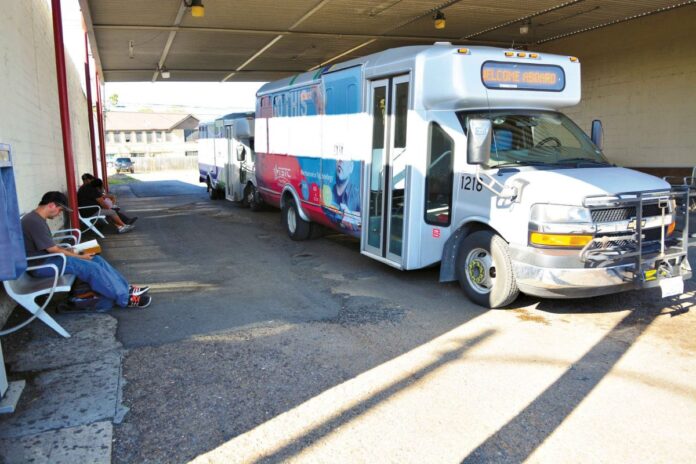HARLINGEN — While the planet obsesses over self-driving cars, one of the oldest forms of mass transportation is enjoying a renaissance in the Rio Grande Valley.
Ridership on Valley Metro, the bus service which spans an area from Brownsville to Zapata County, is forecast to be up 24 percent over last year.
“Primarily it’s because of partnerships we have with South Texas colleges — UTRGV, STC, TSTC,” said Tom Logan, Valley Metro’s director. “The students, the faculty and staff have really started taking advantage of that service, and that’s where we’ve seen that growth in our ridership numbers.”
And who wouldn’t take the bus? For many students, faculty and staff, rides are free with a valid college ID.
Yet the numbers suggest these new riders don’t account for all of the ridership increase.
In fiscal year 2015, September through July, Valley Metro had 435,339 passengers.
Projecting current numbers through this fiscal year, it is estimated ridership will reach 539,400.
“I think it is a great sign that public transit is needed in the area and how we may need to expand the fleet size and services,” said J. Joel Garza Jr., director of the Harlingen-San Benito Metropolitan Planning Organization and a key player in Valley transportation both public and private.
“The problem in the Valley is that people tend to see public transit as only for low-income people and people with disabilities, but that is not the case,” Garza added. “Public transit is meant for everyone. If people would use more public transit than their cars, it would eliminate a lot of traffic congestion in the Valley.”
Building new roads, or merely maintaining old ones, are expensive propositions. Planners like Garza believe public transportation doesn’t just ease congestion, it allows the road funds that are available to be used more efficiently.
When it comes to efficiency, Valley Metro scores high.
Valley Metro and other public transport services break down routes into two categories, urban and non-urbanized, which basically means rural.
On its city routes, Valley Metro’s cost per revenue mile was just $2.84 in the fourth quarter of 2015, while the state average for similar routes was $4.11. Its cost per revenue hour was $53.45, and the state average was $63.50.
Cost-per-passenger rang up on the meter at $1.77, compared to the state average of $4.65.
Its rural routes, like all such routes in Texas, cost more to operate since ridership numbers reflect low rural populations. Yet Valley Metro’s performance measures on those routes beat the state averages in all six categories.
That’s the revenue side, but what about the service side?
Passengers per revenue mile for Valley Metro in the final quarter of 2015 on its urban routes was 1.60 compared to the statewide average of .88. On rural routes, the number was 1.12 passengers per mile which was far higher than the state average of .20
The only one of the six categories in which Valley Metro fell short of the state average was in its urbanized farebox recovery rate, which was 6.69 percent, compared to a state average of 13 percent.
The farebox recovery rate is the fraction of operating expenses which are met by the fares paid by passengers.
“In five out of six categories we’ve surpassed the state average, with the exception of fare recovery in urbanized, because in a lot of our arrangements with colleges and universities, we allow anyone with a college or university ID to ride for free,” Logan said.
The most active routes for passengers in the Valley Metro system are farther up the Valley. Edinburg (the Vaquero Express) accounts for 19 percent of passengers, Weslaco-Pharr-McAllen (JagExpress) accounts for 16 percent and Hidalgo County (Route 31) racks up 13 percent.
Down the Valley, the Port Isabel-Brownsville line (Route 50) garners 12 percent of the system’s passengers.
Harlingen (Routes 40, 41) and San Benito (Route 42) account for 6 percent of the system’s passenger load.
“In the Harlingen area, we see a continuing, modest increase,” Logan said. “We have a lot of medical transportation, a lot of people going to the medical facilities here in Harlingen.”
Both Logan and Garza envision public transport demand increasing in the Harlingen area, and plans are being formed to respond.
The Harlingen-San Benito MPO, Garza said, has a project in the works for a new inter-modal transit facility for Harlingen.
“We are currently working with the City of Harlingen in search of a centralized location for this new facility,” Garza said. “This facility would house all public transit and private transit.
“This facility would also have some retail and/or food vendors very similar to B Metro’s facility in Brownsville,” he added. “Once complete, this is going to be a great project, not only for the HSBMPO area but for the entire Valley.”





